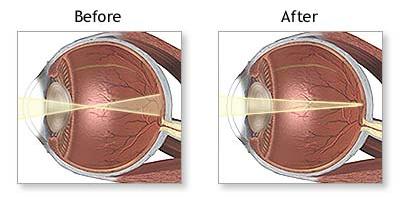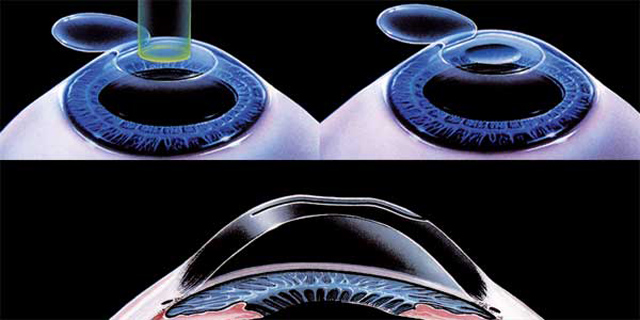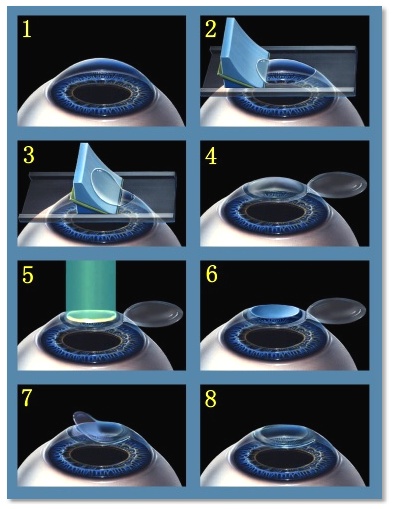Refractive surgery
WE PRESENT TO YOU-REFRACTIVE SURGERY (LASER VISION CORRECTION)LASIK AND PRK refractive procedures
Refractive surgery is a surefire way to get rid of wearing glasses and contact lenses because You quickly and with efficiency release of myopia, hyperopia and astigmatism.
Laser vision correction is a reliable, efficient , simple and painless procedure that permanently reduces or eliminates the initial correction. The result of the intervention is the return of clear vision without glasses or contact lenses.

In MILMEDIC this is performed with the most advanced WaveLight Allegreto (400 Hz) excimer laser which reshapes the cornea, ie. changing its curvature, thus correcting nearsightedness, farsightedness and astigmatism and not only that because if You have for example combined astigmatism and myopia, the laser simultaneously solves them.
LASIK ( laser in-situ keratomileusis) is a method commonly used in the world, Due to its precision and accuracy. However, if You have a "thin" cornea which is not possible to reshape with classic LASIK intervention, there is a solution with the help of PRK (photo refractive keratectomy)
Laser vision correction has been used for the last 30 years (since 1989). Over one million people a year undergo laser vision correction worldwide. Here in Serbia, this procedure was presented several years ago.

MILMEDIC Policlinic has an experienced team of experts led by Professor Miroslav Vukosavljević and both LASIK and tPRK methods a re performed. Both methods are performed on the most advanced WaveLight Allegretto (400Hz) excimer laser with detailed preoperative examination.
WHAT IS A REFRECTIVE ERROR (DIOPTER)?
Diopter is a refractive error that occurs due to irregular refraction of light rays entering the eye. There are myopia (nearsightedness), hyperopia (farsightedness) and astigmatism. Myopia, or nearsightedness, occurs when light rays that pass through the dioptric system of the eye focuses at a point in front of the retina, instead on it. This usually occurs when the cornea is too steep or the eye is too long.
Hyperopia, or farsightedness, occurs when the eye does not focus sufficiently strong and light focuses at a point behind the retina instead of on it. The eye is either too short or the cornea is too flat. Astigmatism is an uneven and irregular curvature of the cornea. Different curvature of the cornea leading to the occurrence of more than one point at which light rays focus, which creates ambiguous vision.
WHAT IS EXCIMER LASER?
Excimer laser is a product of high sophisticated technology that has revolutionized the field of refractive surgery. Thanks to excimer laser the safety, efficiency and predictability of corneal surgeries has been significantly increased. These lasers have the ability to remove microscopic bits of tissue from the stromal layer of the cornea, without damaging the surrounding tissue of the cornea and with no heat emission. The procedure itself is quick and safe. The whole intervention lasts about 15mins per eye and laser treatment itself up to 1min.

AM I A CANDIDATE FOR LASER VISION CORRECTION?
Every person that has a sphere of -10 to 4 is probably a suitable candidate for laser vision correction. However, you need a complete eye examination to determine whether there are any general or ophthalmic contraindications for laser vision correction. Persons over 45 years of age, if they have laser removed diopters for distance, will definitely need glasses for near sight (reading).
WHAT DOES PREOPERATIVE EXAMINATION LOOK LIKE?
Detailed examination (lasting up to 1 h) to determine whether a person is a suitable candidate for laser vision correction and consists of:
- General and ophthalmic history
- Automatic refractokeratometry (ARK) a numerical best-corrected visual acuity
- Schirmer test (examine the secretion of tears)
- Examination of the anterior segment of the eye
- The measurement of intraocular pressure
- Examination of the eye fundus in a wide pupil
- Examination of the anterior segment of the eye at the Allegro Oculyzer, which captures the topography of the cornea, and examining whether the cornea is well built for the intervention of laser vision correction or not.
Each candidate for laser vision correction must be over 21 and must have a stable refractive error for a year. People who wear soft contact lenses pause in wearing them for 7 days, and those who wear hard or rigid gas-permeable contact lenses 30 days prior to the examination and 30 days before the procedure. A method that will be used is determined by a physician and candidate.
WHAT DOES INTERVENTION LOOK LIKE?
LASIK (Laser in-situ keratomileusis) is a procedure which involves two steps.
1. Special instrument called a microkeratome is used to separate a thin superficial layer of the cornea called the "flap". Process is automated, painless and takes a few seconds. Briefly, the vision blurs and you feel increased pressure in the eye.
2. After that, the "flap" is raised and beneath the excimer laser reshapes the stroma of the cornea. Doctor will ask you to focus and to look at the light marker. Then the laser reshapes the stoma of the cornea for 30 to 60 seconds. After that the "flap" goes back into place, antibiotic eye drops are administered and this is the end of the intervention.
PRK (Photorefractive Keratectomy) uses the same excimer laser to reshape the cornea. However, it is done on the surface of the eye and does not need the creation of the "flap". First, epithelial layer is removed in order to reach the stroma and then with the same principle as LASIK, a laser reshapes the stroma of the cornea. Eventually antibiotic drops and therapeutic lens are administered on the eye
.
WHAT TO EXPECT AFTER THE INTERVENTION?;
In the first few days after the intervention, feeling of slight pain and discomfort in the treated eye is possible. Also, the vision can be slightly blurred in those first few days. The first check up control is on the next day. After the tPRK method eye drops are administered for 3 months and after LASIK for a month after the intervention.
The end result is the same for LASIK and PRK and the vision is gradually improving, although a little slower in the tPRK method. Month after the intervention is done, vision should be entirely clear. 7 days after the surgery, patient are able to work.
WHAT ARE THE SIDE EFFECTS OF THE INTERVENTION?
Common side effects include fluctuations in visual acuity, dry eye in the first few weeks, "halo" phenomenon around lights at night (this last symptom usually occurs in the first few weeks after surgery, but usually disappears after a few months), and reduction of contrast sensitivity under low light conditions.
ARE THERE RESTRICTIONS ON ACTIVITIES AFTER SURGERY?
After intervention rest and bed rest at home is recommended. Many patients are able to return to their normal daily routine the next day. You should not rub your eyes or put makeup for a week after the intervention. You shouldn't go swimming a week after the procedure. Avoid all contact with the dust for a week as well as contact sports that could cause injury of the eye over a period of one month. Driving may continue when approved by a physician on regular check-up. You can shower on the first day, but avoid any direct eye contact with water, soap or shampoo
